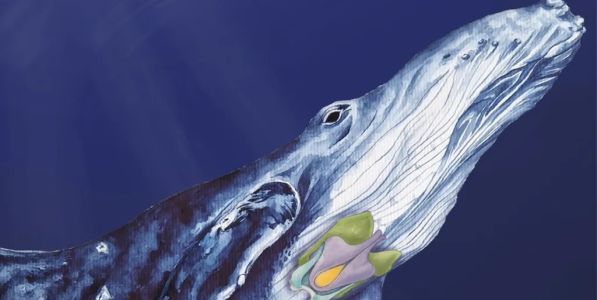
Artwork indicating the cartilages of the larynx in a humpback whale. Patricia Jaqueline Matic, Vienna
For centuries, sailors heard the sounds made by whales reverberating through the hulls of wooden ships. Arctic whalers dubbed beluga whales the “canaries of the seas” for their clicks, chirps, and whistles. Nevertheless, it was long thought that whale noises were nothing more than expressive sounds or calls. That would change in 1967 when Roger Payne was on a research trip to Bermuda, along with a naval engineer who was documenting underwater sounds while listening out for sounds of Russian submarines.
He identified these sounds as humpback and other baleen whales singing to one another. Payne would produce the album “Songs of the Humpback Whale” in 1970. Exactly how they produce these complex, often haunting, songs has remained a mystery.
Now, more than fifty years later, researchers have established the biological mechanism by which baleen whales create their songs. In a paper, published recently in the journal Nature, scientists have identified a specialized “voice box” that has evolved in humpbacks and other baleen whales that enables them to sing underwater.
The discovery has also revealed why the noise we make in the ocean is so disruptive for these ocean giants. Whale song is restricted to a narrow frequency that overlaps with the noise produced by ships.
“Sound is absolutely crucial for their survival because it’s the only way they can find each other to mate in the ocean,” Professor Coen Elemans, of the University of Southern Denmark, who led the study, explained to the BBC.
He and his colleagues carried out experiments using larynxes, or “voice boxes”, that had been carefully removed from three carcasses of stranded whales – a minke, a humpback and a sei whale. They then blew air through the massive structures to produce the sound.
In humans, our voices come from vibrations when air passes over structures called vocal folds in our throats. Baleen whales, instead, have a large U-shaped structure with a cushion of fat at the top of the larynx. This vocal anatomy allows the animals to sing by recycling air, and it prevents water from being inhaled.
The researchers produced computer models of the sounds and showed that baleen whale song is restricted to a narrow frequency which overlaps with noise produced by shipping vessels. “They cannot simply choose to, for example, sing higher to avoid the noise we make in the ocean,” explained Prof Elemans.
His study demonstrated how our ocean noise could prevent whales from communicating over long distances. That knowledge could be vital for the conservation of humpbacks, blue whales, and other endangered giants of the sea.
It also provides insight into questions that researchers have been asking for decades about these eerie songs, which some sailors used to attribute to ghosts or mythical sea creatures.
Whale communication expert Dr. Kate Stafford, from Oregon State University, called the study “groundbreaking”.
Thanks to Alaric Bond for contributing to this post.
